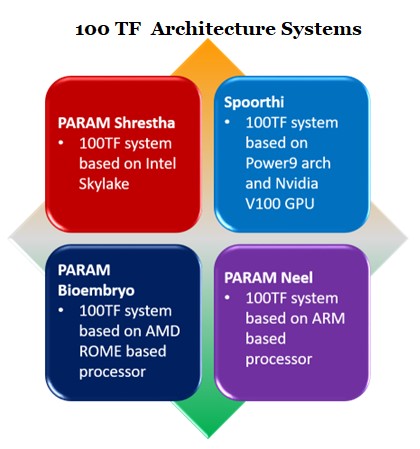Recently, Three PARAM Rudra supercomputers worth Rs 130 crore have been inaugurated.
Giant Metre Radio Telescope (GMRT) in Pune will leverage the supercomputer to explore Fast Radio Bursts (FRBs) and other astronomical phenomena.
|
Supercomputers of India |
||
|
Supercomputer |
Institute |
Capacity and memory |
|
PARAM Shivay |
IIT BHU |
837 teraflops and a total memory of 54.5 TB |
|
PARAM Shakti |
IIT Kharagpur |
1.66 petaFLOPS and a total memory of 103.125 TB |
|
PARAM Brahma |
Indian Institute of Science Education and Research, Pune |
1.75 petaFLOPS and a total memory of 56.8 TB |
|
PARAM Yukti |
Jawaharlal Nehru Centre for Advanced Scientific Research, Bangalore |
1.8 petaFLOPS and a total memory of 52.416 TB |
|
PARAM Sanganak |
IIT Kanpur |
1.67 petaFLOPS and a total memory of 104.832 TB |
|
PARAM Pravega |
Indian Institute of Science, Bangalore |
3.3 petaFLOPS and a total memory of 245.945 TB |
|
PARAM Seva |
IIT Hyderabad |
838 teraFLOPS and a total memory of 52.416 TB |
|
PARAM Smriti |
National Agri-Food Biotechnology Institute, Mohali |
838 teraFLOPS |
|
PARAM Utkarsh |
CDAC, Bangalore |
838 teraFLOPS and a total memory of 52.416 TB |
|
PARAM Ganga |
IIT Roorkee |
1.66 petaFLOPS and a total memory of 104.832 TB |
|
PARAM Ananta |
IIT Gandhinagar |
838 teraFLOPS and a total memory of 52.416 TB |
|
PARAM Porul |
NIT, Trichy |
838 teraFLOPS |
|
PARAM Himalaya |
IIT Mandi |
838 teraFLOPS and a total memory of 52.416 TB |
|
PARAM Kamrupa |
IIT Guwahati |
838 teraFLOPS and a total memory of 52.416 TB |
|
PARAM Siddhi |
AI CDAC, Pune |
5.2 petaFLOPS and 210 petaFLOPS (AI) |
|
Giant Metrewave Radio Telescope, Pune |
1 petaFLOPS |
|
|
Inter-University Accelerator Centre, Delhi |
838 teraFLOPS |
|
|
SN Bose National Centre for Basic Sciences, Kolkata |
838 teraFLOPS |
|
|
Mihir |
NCMRWF |
2.8 petaflop |
